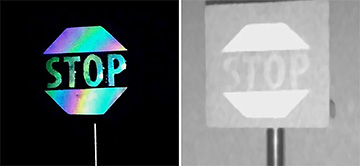
Visible (left) and infrared (right) images of a stop sign created using microscale concave interfaces. The infrared image was taken using a lidar camera. [Image: Jacob Rada]
Engineers from China and the United States have characterized the mechanism behind how a thin film of microscale concave interfaces (MCIs) reflects different colors of light. The team has also demonstrated how the technology might be used in a variety of display applications—including road signs suited to autonomous vehicles (Appl. Mater. Today, doi: 10.1016/j.apmt.2021.101146).
The retroreflective film consists of a thin polyacrylate layer, with partially embedded polymer microspheres 10 µm in diameter. The engineers used experimental observations with different types of light and software simulations to characterize the spectra reflected by the MCIs. By changing the angle of light entering individual MCI “pixels,” they created tunable color displays that could be seen by visual and infrared cameras and detected by lidar sensors.
In addition to signs that play better with self-driving cars, the engineers, led by Qiagiang Gan at the State University of New York at Buffalo, USA, say the thin film technology could also find use in on-chip sensors and anti-counterfeiting tools.
Finding the color key
MCIs have already found use in light-microscopy techniques and iridescent retroreflective tape. However, the developers of these applications have been unaware of the physics behind how the concave microspheres create specific colors. For Gan and his colleagues to create tunable MCI thin-film displays, they first needed to define MCI coloration mechanisms.
In experimental characterizations, the team illuminated the MCI film with white light and observed concentric rainbows reflected on a white board opposite the film. Using a fiber-based spectrometer, the researchers then measured the reflected spectra at different angles. They also measured reflected spectra created from blue, green, red, and infrared light.
Through numerical modeling of the spectrometer data, the engineers determined that the key mechanism of coloration is optical interference caused by light exiting opposite edges of the microspheres embedded in the thin film. In other words, the angle of the light entering the MCI film determines the color of the light exiting the film.
Demonstrating a tunable display
After defining the MCI coloration mechanism, the engineers created a proof-of-concept stop sign to demonstrate how the technology could be used for smart reflective color displays.
To create tunable pixels for the stop-sign array, the team integrated the MCI structure with a dielectric elastomer actuator (DEA). By changing the shape of an individual DEA, Gan’s team controlled the angle of light entering the pixel and therefore the color of the light reflected by the MCI. The resulting stop sign was retroreflective in white and infrared light and was visible from different angles. The team was also able to capture spatial information using a high-resolution lidar camera.
Making autopilot better
“Currently, autopilot systems face many challenges in recognizing traffic signs, especially in real-world conditions,” said Gan in a press release accompanying the research. “Smart traffic signs made from our material could provide more signals for future systems that use lidar and visible pattern recognition together to identify important traffic signs. This may be helpful to improve the traffic safety for autonomous cars.”
The engineers have filed patents in China and the United States for the MCI material, and the technology is now available for licensing.
